Portal maintenance status: (June 2018)
|
The Reptiles Portal


Reptiles, as commonly defined, are a group of tetrapods with an ectothermic ('cold-blooded') metabolism and amniotic development. Living reptiles comprise four orders: Testudines (turtles), Crocodilia (crocodilians), Squamata (lizards and snakes), and Rhynchocephalia (the tuatara). As of May 2023, about 12,000 living species of reptiles are listed in the Reptile Database. The study of the traditional reptile orders, customarily in combination with the study of modern amphibians, is called herpetology.
Reptiles have been subject to several conflicting taxonomic definitions. In Linnaean taxonomy, reptiles are gathered together under the class Reptilia (/rɛpˈtɪliə/ rep-TIL-ee-ə), which corresponds to common usage. Modern cladistic taxonomy regards that group as paraphyletic, since genetic and paleontological evidence has determined that birds (class Aves), as members of Dinosauria are more closely related to living crocodilians than to other reptiles, and are thus nested among reptiles from an evolutionary perspective. Many cladistic systems therefore redefine Reptilia as a clade (monophyletic group) including birds, though the precise definition of this clade varies between authors. Others prioritize the clade Sauropsida, which typically refers to all amniotes more closely related to modern reptiles than to mammals.
The earliest known proto-reptiles originated around 312 million years ago during the Carboniferous period, having evolved from advanced reptiliomorph tetrapods which became increasingly adapted to life on dry land. The earliest known eureptile ("true reptile") was Hylonomus, a small and superficially lizard-like animal. Genetic and fossil data argues that the two largest lineages of reptiles, Archosauromorpha (crocodilians, birds, and kin) and Lepidosauromorpha (lizards, and kin), diverged near the end of the Permian period. In addition to the living reptiles, there are many diverse groups that are now extinct, in some cases due to mass extinction events. In particular, the Cretaceous–Paleogene extinction event wiped out the pterosaurs, plesiosaurs, and all non-avian dinosaurs alongside many species of crocodyliforms, and squamates (e.g., mosasaurs). Modern non-bird reptiles inhabit all the continents except Antarctica. (Full article...)
Reptile types
![Image 1Yacare caiman, Caiman yacareA caiman (/ˈkeɪmən/; also cayman as a variant spelling from Taíno kaiman[additional citation(s) needed]) is an alligatorid belonging to the subfamily Caimaninae, one of two primary lineages within the Alligatoridae family, the other being alligators. Caimans inhabit Mexico and Central & South America from marshes and swamps to mangrove rivers and lakes. They have scaly skin and live a fairly nocturnal existence. They are relatively small-sized crocodilians with an average maximum weight of 6 to 40 kg (13 to 88 lb) depending on species, with the exception of the black caiman (Melanosuchus niger), which can grow more than 4 m (13 ft) in length and weigh in excess of 1,000 kg (2,200 Ib). The black caiman is the largest caiman species in the world and is found in the slow-moving rivers and lakes that surround the Amazon basin. The smallest species is the Cuvier's dwarf caiman (Paleosuchus palpebrosus), which grows to 1.2 to 1.5 m (3.9 to 4.9 ft) long. There are six different species of caiman found throughout the watery jungle habitats of Central and Southern America. The average length for most of the other caiman species is about 2 to 2.5 m (6.6 to 8.2 ft) long. (Full article...)](../I/Blank.png.webp) Image 1
Image 1 Yacare caiman, Caiman yacare
Yacare caiman, Caiman yacare
A caiman (/ˈkeɪmən/; also cayman as a variant spelling from Taíno kaiman) is an alligatorid belonging to the subfamily Caimaninae, one of two primary lineages within the Alligatoridae family, the other being alligators. Caimans inhabit Mexico and Central & South America from marshes and swamps to mangrove rivers and lakes. They have scaly skin and live a fairly nocturnal existence. They are relatively small-sized crocodilians with an average maximum weight of 6 to 40 kg (13 to 88 lb) depending on species, with the exception of the black caiman (Melanosuchus niger), which can grow more than 4 m (13 ft) in length and weigh in excess of 1,000 kg (2,200 Ib). The black caiman is the largest caiman species in the world and is found in the slow-moving rivers and lakes that surround the Amazon basin. The smallest species is the Cuvier's dwarf caiman (Paleosuchus palpebrosus), which grows to 1.2 to 1.5 m (3.9 to 4.9 ft) long. There are six different species of caiman found throughout the watery jungle habitats of Central and Southern America. The average length for most of the other caiman species is about 2 to 2.5 m (6.6 to 8.2 ft) long. (Full article...) Image 2
Image 2 Turtles from different families; clockwise from top-left: Red-bellied short-necked turtle, Indian flapshell turtle, Hawksbill sea turtle, and Galápagos tortoise
Turtles from different families; clockwise from top-left: Red-bellied short-necked turtle, Indian flapshell turtle, Hawksbill sea turtle, and Galápagos tortoise
Turtles are reptiles of the order Testudines, characterized by a special shell developed mainly from their ribs. Modern turtles are divided into two major groups, the Pleurodira (side necked turtles) and Cryptodira (hidden necked turtles), which differ in the way the head retracts. There are 360 living and recently extinct species of turtles, including land-dwelling tortoises and freshwater terrapins. They are found on most continents, some islands and, in the case of sea turtles, much of the ocean. Like other amniotes (reptiles, birds, and mammals) they breathe air and do not lay eggs underwater, although many species live in or around water. (Full article...) Image 3
Image 3
Snakes are elongated, limbless, carnivorous reptiles of the suborder Serpentes (/sɜːrˈpɛntiːz/). Like all other squamates, snakes are ectothermic, amniote vertebrates covered in overlapping scales. Many species of snakes have skulls with several more joints than their lizard ancestors, enabling them to swallow prey much larger than their heads (cranial kinesis). To accommodate their narrow bodies, snakes' paired organs (such as kidneys) appear one in front of the other instead of side by side, and most have only one functional lung. Some species retain a pelvic girdle with a pair of vestigial claws on either side of the cloaca. Lizards have independently evolved elongate bodies without limbs or with greatly reduced limbs at least twenty-five times via convergent evolution, leading to many lineages of legless lizards. These resemble snakes, but several common groups of legless lizards have eyelids and external ears, which snakes lack, although this rule is not universal (see Amphisbaenia, Dibamidae, and Pygopodidae). (Full article...) Image 4
Image 4 Aldabra giant tortoise
Aldabra giant tortoise
(Aldabrachelys gigantea)
Tortoises (/ˈtɔːr.təs.ɪz/) are reptiles of the family Testudinidae of the order Testudines (Latin for "tortoise"). Like other turtles, tortoises have a shell to protect from predation and other threats. The shell in tortoises is generally hard, and like other members of the suborder Cryptodira, they retract their necks and heads directly backward into the shell to protect them. (Full article...) Image 5
Image 5.jpg.webp) Northern tuatara (Sphenodon punctatus punctatus)
Northern tuatara (Sphenodon punctatus punctatus)
Tuatara (Sphenodon punctatus) are reptiles endemic to New Zealand. Despite their close resemblance to lizards, they are part of a distinct lineage, the order Rhynchocephalia. The name tuatara is derived from the Māori language and means "peaks on the back". (Full article...) Image 6
Image 6_male.jpg.webp) Male gharial
Male gharial
The gharial (Gavialis gangeticus), also known as gavial or fish-eating crocodile, is a crocodilian in the family Gavialidae and among the longest of all living crocodilians. Mature females are 2.6 to 4.5 m (8 ft 6 in to 14 ft 9 in) long, and males 3 to 6 m (9 ft 10 in to 19 ft 8 in). Adult males have a distinct boss at the end of the snout, which resembles an earthenware pot known as a ghara, hence the name "gharial". The gharial is well adapted to catching fish because of its long, narrow snout and 110 sharp, interlocking teeth. (Full article...) Image 7
Image 7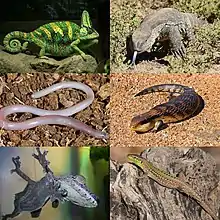 Clockwise from top left: veiled chameleon (Chamaeleo calyptratus), rock monitor (Varanus albigularis), common blue-tongued skink (Tiliqua scincoides), Italian wall lizard (Podarcis sicula), giant leaf-tailed gecko (Uroplatus fimbriatus), and legless lizard (Anelytropsis papillosus)
Clockwise from top left: veiled chameleon (Chamaeleo calyptratus), rock monitor (Varanus albigularis), common blue-tongued skink (Tiliqua scincoides), Italian wall lizard (Podarcis sicula), giant leaf-tailed gecko (Uroplatus fimbriatus), and legless lizard (Anelytropsis papillosus)
Lizard is the common name used for all squamate reptiles other than snakes (and to a lesser extent amphisbaenians), encompassing over 7,000 species, ranging across all continents except Antarctica, as well as most oceanic island chains. The grouping is paraphyletic as some lizards are more closely related to snakes than they are to other lizards. Lizards range in size from chameleons and geckos a few centimeters long to the 3-meter-long Komodo dragon. (Full article...) Image 8
Image 8 Nile crocodile (Crocodylus niloticus)
Nile crocodile (Crocodylus niloticus)
Crocodiles (family Crocodylidae) or true crocodiles are large semiaquatic reptiles that live throughout the tropics in Africa, Asia, the Americas and Australia. The term crocodile is sometimes used even more loosely to include all extant members of the order Crocodilia, which includes the alligators and caimans (family Alligatoridae), the gharial and false gharial (family Gavialidae) among other extinct taxa. (Full article...) Image 9
Image 9 An American alligator (top) and a Chinese alligator
An American alligator (top) and a Chinese alligator
An alligator, or colloquially gator, is a large reptile in the Crocodilia order in the genus Alligator of the family Alligatoridae. The two extant species are the American alligator (A. mississippiensis) and the Chinese alligator (A. sinensis). Additionally, several extinct species of alligator are known from fossil remains. Alligators first appeared during the Oligocene epoch about 37 million years ago. (Full article...) Image 10
Image 10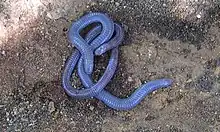 Blanus cinereus, Spain
Blanus cinereus, Spain
Amphisbaenia /æmfɪsˈbiːniə/ (called amphisbaenians or worm lizards) is a group of typically legless lizards, comprising over 200 extant species. Amphisbaenians are characterized by their long bodies, the reduction or loss of the limbs, and rudimentary eyes. As many species have a pink body and scales arranged in rings, they have a superficial resemblance to earthworms. While the genus Bipes retains forelimbs, all other genera are limbless. Recent phylogenetic studies suggest that they are nested within Lacertoidea, closed related to the lizard family Lacertidae. Amphisbaenians are widely distributed, occurring in North America, Europe, Africa, South America, Western Asia and the Caribbean. Most species are less than 6 inches (15 cm) long. (Full article...)
Selected images

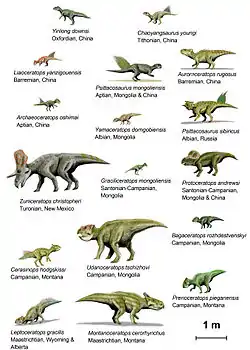 Image 2Image credit: ArthurWeasleyDiagram showing the appearances and relative sizes of 18 basal species of Ceratopsians (frilled, beaked dinosaurs typified by Triceratops). Animals are shown in order of geologic stage from left to right and top to bottom, with species names and stage information as annotation.
Image 2Image credit: ArthurWeasleyDiagram showing the appearances and relative sizes of 18 basal species of Ceratopsians (frilled, beaked dinosaurs typified by Triceratops). Animals are shown in order of geologic stage from left to right and top to bottom, with species names and stage information as annotation.
Ceratopsians were beaked herbivores who lived in what are now North America and Asia, during the Cretaceous Period. Early members such as Psittacosaurus were small and bipedal. Later members, including ceratopsids like Centrosaurus and Triceratops, became very large quadrupeds and developed elaborate facial horns and a neck frill._2.jpg.webp) Image 3Photograph: Charles J. SharpThe yacare caiman (Caiman yacare) is a species of caiman found in central South America. About ten million individuals, such as this one, exist within the Brazilian pantanal, representing what may be the largest single crocodilian population on Earth. This small-to-medium sized species feeds mainly on fish (especially piranha), but also eats birds, reptiles, and small mammals.
Image 3Photograph: Charles J. SharpThe yacare caiman (Caiman yacare) is a species of caiman found in central South America. About ten million individuals, such as this one, exist within the Brazilian pantanal, representing what may be the largest single crocodilian population on Earth. This small-to-medium sized species feeds mainly on fish (especially piranha), but also eats birds, reptiles, and small mammals. Image 4Photo: Tancrède Dumas; Restoration: Lise BroerA late nineteenth century photo of snake charmers in Tangier, Morocco. Snake charming is the practice of apparently hypnotising a snake, and the performance may use musical instruments and other street performance techniques. The practice as it exists today probably arose in India, where it remains widely practiced, and spread throughout Southeast Asia, the Middle East, and North Africa.
Image 4Photo: Tancrède Dumas; Restoration: Lise BroerA late nineteenth century photo of snake charmers in Tangier, Morocco. Snake charming is the practice of apparently hypnotising a snake, and the performance may use musical instruments and other street performance techniques. The practice as it exists today probably arose in India, where it remains widely practiced, and spread throughout Southeast Asia, the Middle East, and North Africa._female_Andasibe_2.jpg.webp) Image 5Photograph credit: Charles James SharpParson's chameleon (Calumma parsonii) is a large species of chameleon, a lizard in the family Chamaeleonidae. The species is endemic to isolated pockets of humid primary forest in eastern and northern Madagascar. It is listed on CITES Appendix II, meaning that trade in this species is regulated. While it is illegal for most chameleon species from Madagascar to be exported, a limited number of Parson's chameleons can legally be exported each year from its native country. This female Parson's chameleon of the subspecies C. p. cristifer was photographed near Andasibe, Moramanga.
Image 5Photograph credit: Charles James SharpParson's chameleon (Calumma parsonii) is a large species of chameleon, a lizard in the family Chamaeleonidae. The species is endemic to isolated pockets of humid primary forest in eastern and northern Madagascar. It is listed on CITES Appendix II, meaning that trade in this species is regulated. While it is illegal for most chameleon species from Madagascar to be exported, a limited number of Parson's chameleons can legally be exported each year from its native country. This female Parson's chameleon of the subspecies C. p. cristifer was photographed near Andasibe, Moramanga.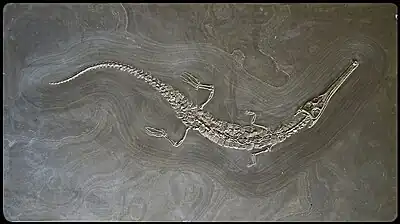 Image 6Photograph: Didier DescouensA fossil of Steneosaurus bollensis, from the extinct genus of teleosaurid crocodyliforms Steneosaurus. This specimen was found in Holzmaden, Germany, and dates from the Early Jurassic (185 million years ago).
Image 6Photograph: Didier DescouensA fossil of Steneosaurus bollensis, from the extinct genus of teleosaurid crocodyliforms Steneosaurus. This specimen was found in Holzmaden, Germany, and dates from the Early Jurassic (185 million years ago). Image 7Photograph: Steevven1The gold dust day gecko (Phelsuma laticauda) is a diurnal species of gecko. Endemic to northern Madagascar and the Comoros, it has been introduced to Hawaii and other Pacific islands. It typically inhabits trees and houses, and feeds on insects and nectar.
Image 7Photograph: Steevven1The gold dust day gecko (Phelsuma laticauda) is a diurnal species of gecko. Endemic to northern Madagascar and the Comoros, it has been introduced to Hawaii and other Pacific islands. It typically inhabits trees and houses, and feeds on insects and nectar.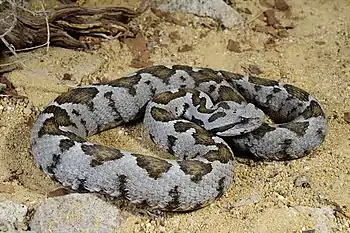 Image 8Photo: Benny TrappVipera xanthina is a venomous viper species found in northeastern Greece and Turkey, as well as certain islands in the Aegean Sea. The species, which averages 70–95 cm (27.6–37.4 in) in length, feeds on small mammals and birds.
Image 8Photo: Benny TrappVipera xanthina is a venomous viper species found in northeastern Greece and Turkey, as well as certain islands in the Aegean Sea. The species, which averages 70–95 cm (27.6–37.4 in) in length, feeds on small mammals and birds.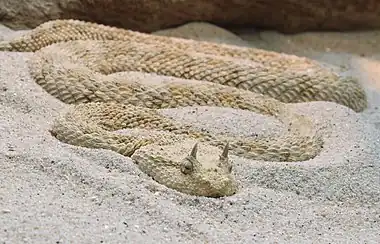 Image 9Cerastes cerastes, commonly known as the Saharan horned viper or the horned desert viper, is a venomous species of viper native to the deserts of northern Africa and parts of the Arabian Peninsula and Levant. It often is easily recognized by the presence of a pair of supraocular "horns", although hornless individuals do occur.
Image 9Cerastes cerastes, commonly known as the Saharan horned viper or the horned desert viper, is a venomous species of viper native to the deserts of northern Africa and parts of the Arabian Peninsula and Levant. It often is easily recognized by the presence of a pair of supraocular "horns", although hornless individuals do occur. Image 10Green sea turtle
Image 10Green sea turtle Image 11Photo: Ianaré SéviThe Northern Curly-tailed Lizard (Leiocephalus carinatus) is a lizard species from the family of curly-tailed lizards (Leiocephalidae). It is native to the Bahamas, the Cayman Islands and Cuba, but was released intentionally in Palm Beach, Florida, in the 1940s. An active, robust lizard, it is mostly terrestrial and will retreat into a burrow or cavity when frightened. It prefers sunny areas with loose rubble and rock.
Image 11Photo: Ianaré SéviThe Northern Curly-tailed Lizard (Leiocephalus carinatus) is a lizard species from the family of curly-tailed lizards (Leiocephalidae). It is native to the Bahamas, the Cayman Islands and Cuba, but was released intentionally in Palm Beach, Florida, in the 1940s. An active, robust lizard, it is mostly terrestrial and will retreat into a burrow or cavity when frightened. It prefers sunny areas with loose rubble and rock.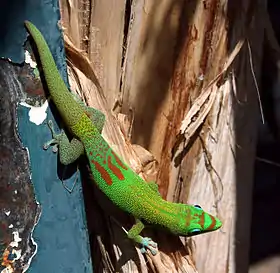 Image 12Photo: Thierry CaroThe Gold dust day gecko (Phelsuma laticauda) is a diurnal species of day gecko native to Madagascar and the Comoros, although it has been introduced to Hawaii and other Pacific islands. It grows to about 15–22 cm (6–9 in) in length and is bright green or yellowish green with rufous bars on the snout and head, and red bars on the lower back.
Image 12Photo: Thierry CaroThe Gold dust day gecko (Phelsuma laticauda) is a diurnal species of day gecko native to Madagascar and the Comoros, although it has been introduced to Hawaii and other Pacific islands. It grows to about 15–22 cm (6–9 in) in length and is bright green or yellowish green with rufous bars on the snout and head, and red bars on the lower back.
 Image 14Photo credit: Paul HirstAn anole lizard of the family Polychrotidae found in Hilo, Hawaii, United States. Anoles are small and common lizards that can be found throughout the various regions of the Western Hemisphere. They are frequently and incorrectly called chameleons or geckos due to their ability to alter their skin color and run up walls, respectively.
Image 14Photo credit: Paul HirstAn anole lizard of the family Polychrotidae found in Hilo, Hawaii, United States. Anoles are small and common lizards that can be found throughout the various regions of the Western Hemisphere. They are frequently and incorrectly called chameleons or geckos due to their ability to alter their skin color and run up walls, respectively..jpg.webp) Image 15Photograph: Yathin S KrishnappaThe Namaqua chameleon (Chamaeleo namaquensis) is a lizard found in the western desert regions of Namibia, South Africa, and southern Angola. This species, which can reach 25 cm (9.8 in) in length, is common in the Namib Desert. It has evolved several adaptations which allow it to thrive in hot and arid areas, such as the ability to change color to control temperature.
Image 15Photograph: Yathin S KrishnappaThe Namaqua chameleon (Chamaeleo namaquensis) is a lizard found in the western desert regions of Namibia, South Africa, and southern Angola. This species, which can reach 25 cm (9.8 in) in length, is common in the Namib Desert. It has evolved several adaptations which allow it to thrive in hot and arid areas, such as the ability to change color to control temperature. Image 16Photo: Muhammad Mahdi KarimThe dwarf yellow-headed gecko (Lygodactylus luteopicturatus) is a small gecko species native to the rocky areas of southern Kenya, eastern Tanzania, and Zanzibar. This individual's tail, which had been shed through autotomy, is regenerating.
Image 16Photo: Muhammad Mahdi KarimThe dwarf yellow-headed gecko (Lygodactylus luteopicturatus) is a small gecko species native to the rocky areas of southern Kenya, eastern Tanzania, and Zanzibar. This individual's tail, which had been shed through autotomy, is regenerating. Image 17Asian vine snake Ahaetulla prasina. This snake has a wide distribution in Asia. It feeds on small reptiles and amphibians, particularly lizards and tree frogs. Adults may attain 1.8 m (6 feet) in total length, with a tail 0.6 m (2 feet) long. Its appearance is very much like those of South American vine snakes. It is a rear-fanged species and is mildly venomous but is not considered a threat to humans.
Image 17Asian vine snake Ahaetulla prasina. This snake has a wide distribution in Asia. It feeds on small reptiles and amphibians, particularly lizards and tree frogs. Adults may attain 1.8 m (6 feet) in total length, with a tail 0.6 m (2 feet) long. Its appearance is very much like those of South American vine snakes. It is a rear-fanged species and is mildly venomous but is not considered a threat to humans. Image 18Photograph: H. KrispPhelsuma grandis is a species of day gecko that lives in Madagascar. Found in a wide range of habitats, it can measure up to 30 centimetres (12 in) in length.
Image 18Photograph: H. KrispPhelsuma grandis is a species of day gecko that lives in Madagascar. Found in a wide range of habitats, it can measure up to 30 centimetres (12 in) in length. Image 19Photograph: Ministry of Information and Tourism of EcuadorA Julia butterfly (Dryas iulia) feeding on the tears of a red-headed Amazon River turtle (Podocnemis erythrocephala) in Ecuador. Such lachryphagy provides the butterfly with additional minerals that it can use for spermatophore production.
Image 19Photograph: Ministry of Information and Tourism of EcuadorA Julia butterfly (Dryas iulia) feeding on the tears of a red-headed Amazon River turtle (Podocnemis erythrocephala) in Ecuador. Such lachryphagy provides the butterfly with additional minerals that it can use for spermatophore production. Image 20Photo credit: Marcel Burkhard (cele4)The Plumed Basilisk (Basiliscus plumifrons) is a species of lizard native to Latin America. Its natural range covers a swath from Mexico to Ecuador.
Image 20Photo credit: Marcel Burkhard (cele4)The Plumed Basilisk (Basiliscus plumifrons) is a species of lizard native to Latin America. Its natural range covers a swath from Mexico to Ecuador.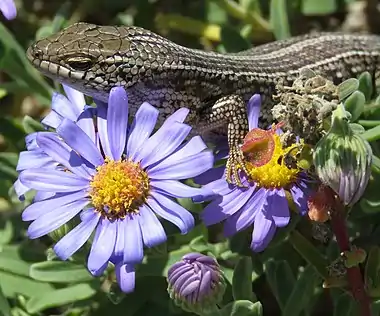
 Image 22Photo credit: John O'NeillA common snakeneck turtle (Chelodina longicollis) covered in camouflaging algae. When resting this individual would look like an algae-covered rock, an example of crypsis, the ability of an organism to avoid observation. Other ways an organism may be cryptic include nocturnality, subterranean lifestyle, and transparency.
Image 22Photo credit: John O'NeillA common snakeneck turtle (Chelodina longicollis) covered in camouflaging algae. When resting this individual would look like an algae-covered rock, an example of crypsis, the ability of an organism to avoid observation. Other ways an organism may be cryptic include nocturnality, subterranean lifestyle, and transparency._on_a_tree_trunk.jpg.webp) Image 23Photograph credit: Basile MorinEutropis macularia, the bronze grass skink, is a species of lizard in the skink family, Scincidae, native to South and Southeast Asia. It lives in both deciduous and evergreen forests, in plantations, in grasslands, and in rocky areas with scattered trees. The species is active in both the day and the night, feeding on insects and other invertebrates. This bronze grass skink was photographed on a tree trunk on the island of Don Det in Laos.
Image 23Photograph credit: Basile MorinEutropis macularia, the bronze grass skink, is a species of lizard in the skink family, Scincidae, native to South and Southeast Asia. It lives in both deciduous and evergreen forests, in plantations, in grasslands, and in rocky areas with scattered trees. The species is active in both the day and the night, feeding on insects and other invertebrates. This bronze grass skink was photographed on a tree trunk on the island of Don Det in Laos.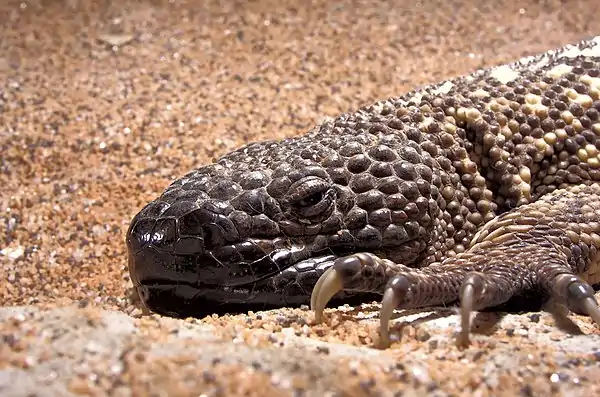 Image 24
Image 24 Image 25
Image 25
Selected Crocodilia articles
 Image 1
Image 1
The Chinese alligator (Alligator sinensis; simplified Chinese: 鼍; traditional Chinese: 鼉; pinyin: tuó), also known as the Yangtze alligator (simplified Chinese: 扬子鳄; traditional Chinese: 揚子鱷; pinyin: yángzǐ'è), China alligator, or historically the muddy dragon, is a crocodilian endemic to China. It and the American alligator (A. mississippiensis) are the only living species in the genus Alligator of the family Alligatoridae. Dark gray or black in color with a fully armored body, the Chinese alligator grows to 1.5–2.1 metres (5–7 ft) in length and weighs 36–45 kilograms (80–100 lb) as an adult. It brumates in burrows in winter and is nocturnal in summer. Mating occurs in early summer, with females most commonly producing 20–30 eggs, which are smaller than those of any other crocodilian. The species is an opportunistic feeder, primarily eating fish and invertebrates. A vocal species, adults bellow during the mating season and young vocalize to communicate with their parents and other juveniles. Captive specimens have reached age 70, and wild specimens can live past 50.
Living in bodies of fresh water, the Chinese alligator's range is restricted to six regions in the province of Anhui, as well as possibly the provinces of Jiangsu and Zhejiang. Originally living as far away from its current range as Japan, the species previously had a wide range and population, but beginning in 6000 BC, multiple threats, such as habitat destruction, caused the species' population and range to decline. The population in the wild was about 1,000 in the 1970s, decreased to below 130 in 2001, and grew after 2003, with its population being about 300 as of 2017. Listed as critically endangered by the International Union for Conservation of Nature, multiple conservation actions have been taking place for this species. (Full article...) Image 2
Image 2 An adult basking on the island of Palawan, Philippines
An adult basking on the island of Palawan, Philippines
The Philippine crocodile (Crocodylus mindorensis), also known as the Mindoro crocodile, the Philippine freshwater crocodile, the bukarot in Ilocano, and more generally as a buwaya in most Filipino lowland cultures, is one of two species of crocodiles found in the Philippines; the other is the larger saltwater crocodile (Crocodylus porosus). The Philippine crocodile, the species endemic only to the country, went from data deficient to critically endangered in 2008 from exploitation and unsustainable fishing methods, such as dynamite fishing. Conservation methods are being taken by the Dutch/Filipino Mabuwaya foundation, the Crocodile Conservation Society and the Zoological Institute of HerpaWorld in Mindoro island. It is strictly prohibited to kill a crocodile in the country, and it is punishable by law. (Full article...) Image 3
Image 3_Gal_Oya.jpg.webp)
The mugger crocodile (Crocodylus palustris) is a medium-sized broad-snouted crocodile, also known as mugger and marsh crocodile. It is native to freshwater habitats from southern Iran to the Indian subcontinent, where it inhabits marshes, lakes, rivers and artificial ponds. It rarely reaches a body length of 5 m (16 ft 5 in) and is a powerful swimmer, but also walks on land in search of suitable waterbodies during the hot season. Both young and adult mugger crocodiles dig burrows to which they retreat when the ambient temperature drops below 5 °C (41 °F) or exceeds 38 °C (100 °F). Females dig holes in the sand as nesting sites and lay up to 46 eggs during the dry season. The sex of hatchlings depends on temperature during incubation. Both parents protect the young for up to one year. They feed on insects, and adults prey on fish, reptiles, birds and mammals.
The mugger crocodile evolved at least 4.19 million years ago and has been a symbol for the fructifying and destructive powers of the rivers since the Vedic period. It was first scientifically described in 1831 and is protected by law in Iran, India and Sri Lanka. Since 1982, it has been listed as Vulnerable on the IUCN Red List. Outside protected areas, it is threatened by conversion of natural habitats, gets entangled in fishing nets and is killed in human–wildlife conflict situations and in traffic accidents. (Full article...) Image 4
Image 4_(28742110492).jpg.webp) Mato Grosso, Brazil
Mato Grosso, Brazil
The yacare caiman (Caiman yacare), also known commonly as the jacare caiman, Paraguayan caiman, piranha caiman, red caiman, and southern spectacled caiman, is a species of caiman, a crocodilian in the family Alligatoridae. The species is endemic to Argentina, Bolivia, Brazil, and Paraguay. Brown in color and covered with dark blotches, males grow to a total length (including tail) of 2–3 m (6 ft 7 in – 9 ft 10 in) and weigh around 40–50 kg (88–110 lb); while females grow to 1.4 m (4 ft 7 in) long and about 15–20 kg (33–44 lb). Typical habitats of this caiman include lakes, rivers, and wetlands. Its diet primarily consists of aquatic animals, such as snails, and occasionally land vertebrates. Mating occurs in the rainy season and eggs hatch in March, with young fending for themselves as soon as they hatch. The yacare caiman was hunted heavily for its skin to use for leather in the 1980s, which caused its population to decrease significantly. However, trading restrictions placed since have caused its population to increase. Its population in the Pantanal is about 10 million, and it is listed as least concern on the IUCN Red List. (Full article...) Image 5
Image 5
The freshwater crocodile (Crocodylus johnstoni), also known as the Australian freshwater crocodile, Johnstone's crocodile or the freshie, is a species of crocodile endemic to the northern regions of Australia. Unlike their much larger Australian relative, the saltwater crocodile, freshwater crocodiles are not known as man-eaters, although they bite in self-defence, and brief, nonfatal attacks have occurred, apparently the result of mistaken identity. (Full article...) Image 6
Image 6
The dwarf crocodile (Osteolaemus tetraspis), also known as the African dwarf crocodile, broad-snouted crocodile (a name more often used for the Asian mugger crocodile) or bony crocodile, is an African crocodile that is also the smallest extant (living) species of crocodile. (Full article...) Image 7
Image 7 At Zapata Swamp, Matanzas Province, Cuba
At Zapata Swamp, Matanzas Province, Cuba
The Cuban crocodile (Crocodylus rhombifer) is a small-medium species of crocodile endemic to Cuba. Typical length is 2.1–2.3 m (6.9–7.5 ft) and typical weight 70–80 kg (150–180 lb). Large males can reach as much as 3.5 m (11 ft) in length and weigh more than 215 kg (474 lb). Despite its smaller size, it is a highly aggressive animal (one of the most territorial of all crocodilians), and potentially dangerous to humans.
The Cuban crocodile is of interest to biologists, for its unique physical and behavioral traits. Long- and strong-legged, it is the most terrestrial of extant crocodiles. Its preferred habitat comprises freshwater and brackish water environments, such as mangrove swamps, coastal lagoons, estuaries, marshes, floodplains, and river deltas. There, the adults feed on fish, turtles and small mammals, while the young eat invertebrates and smaller fish. Mating occurs between May and July. Captive animals have displayed cooperative hunting behavior, and can be taught tricks, suggesting intelligence. (Full article...) Image 8
Image 8
Mecistops is a genus of crocodiles, the slender-snouted crocodiles, native to sub-Saharan Africa. (Full article...) Image 9
Image 9 At La Manzanilla, Jalisco, Mexico
At La Manzanilla, Jalisco, Mexico
The American crocodile (Crocodylus acutus) is a species of crocodilian found in the Neotropics. It is the most widespread of the four extant species of crocodiles from the Americas, with populations present from South Florida and the coasts of Mexico to as far south as Peru and Venezuela.
The habitat of the American crocodile consists largely of coastal areas. It is also found in river systems, but tends to prefer salinity, resulting in the species congregating in brackish lakes, mangrove swamps, lagoons, cays, and small islands. Other crocodiles also have tolerance to saltwater due to salt glands underneath the tongue, but the American crocodile is the only species other than the saltwater crocodile to commonly live and thrive in saltwater. They can be found on beaches and small island formations without any freshwater source, such as many cays and islets across the Caribbean. They are also found in hypersaline lakes; one of the largest known populations inhabits Lago Enriquillo in the Dominican Republic. (Full article...) Image 10
Image 10
The broad-snouted caiman (Caiman latirostris) is a crocodilian in the family Alligatoridae found in eastern and central South America, including southeastern Brazil, northern Argentina, Uruguay, Paraguay, and Bolivia. It is found mostly in freshwater marshes, swamps, and mangroves, usually in still or very slow-moving waters. It will often use man-made cow ponds. (Full article...) Image 11
Image 11.jpg.webp)
The saltwater crocodile (Crocodylus porosus) is a crocodilian native to saltwater habitats, brackish wetlands and freshwater rivers from India's east coast across Southeast Asia and the Sundaic region to northern Australia and Micronesia. It has been listed as Least Concern on the IUCN Red List since 1996. It was hunted for its skin throughout its range up to the 1970s, and is threatened by illegal killing and habitat loss. It is regarded as dangerous to humans.
The saltwater crocodile is the largest living reptile. Males can grow up to a weight of 1,000–1,500 kg (2,200–3,300 lb) and a length of 6 m (20 ft), rarely exceeding 6.3 m (21 ft). Females are much smaller and rarely surpass 3 m (9.8 ft). It is also called the estuarine crocodile, Indo-Pacific crocodile, marine crocodile, sea crocodile, and, informally, the saltie. A large and opportunistic hypercarnivorous apex predator, they ambush most of their prey and then drown or swallow it whole. They will prey on almost any animal that enters their territory, including other predators such as sharks, varieties of freshwater and saltwater fish including pelagic species, invertebrates such as crustaceans, various amphibians, reptiles, birds, and mammals, including humans. (Full article...) Image 12
Image 12 New Guinea crocodile at Bandung Zoo in West Java, Indonesia
New Guinea crocodile at Bandung Zoo in West Java, Indonesia
The New Guinea crocodile (Crocodylus novaeguineae) is a small species of crocodile found on the island of New Guinea north of the mountain ridge that runs along the centre of the island. The population found south of the mountain ridge, formerly considered a genetically distinct population, is now considered a distinct species, Hall's New Guinea crocodile (C. halli). In the past it included the Philippine crocodile, C. n. mindorensis, as a subspecies, but today they are regarded as separate species. The habitat of the New Guinea crocodile is mostly freshwater swamps and lakes. It is most active at night when it feeds on fish and a range of other small animals. A female crocodile lays a clutch of eggs in a nest composed of vegetation and she lies up nearby to guard the nest. There is some degree of parental care for newly hatched juveniles. This crocodile was over-hunted for its valuable skin in the mid 20th century, but conservation measures have since been put in place, it is reared in ranches and the International Union for Conservation of Nature (IUCN) lists it as being of "Least Concern". (Full article...) Image 13
Image 13
Morelet's crocodile (Crocodylus moreletii), also known as the Mexican crocodile or Belize crocodile, is a modest-sized crocodilian found only in fresh waters of the Atlantic regions of Mexico, Belize and Guatemala. It usually grows to about 3 metres (10 ft) in length. It is a Least Concern species.
The species has a fossil record in Guatemala. (Full article...) Image 14
Image 14 At the Columbus Zoo and Aquarium in Powell, Ohio
At the Columbus Zoo and Aquarium in Powell, Ohio
The American alligator (Alligator mississippiensis), sometimes referred to colloquially as a gator or common alligator, is a large crocodilian reptile native to the Southeastern United States. It is one of the two extant species in the genus Alligator, and is larger than the only other living alligator species, the Chinese alligator.
Adult male American alligators measure 3.4 to 4.6 m (11.2 to 15.1 ft) in length, and can weigh up to 500 kg (1,100 lb), with unverified sizes of up to 5.84 m (19.2 ft) and weights of 1,000 kg (2,200 lb) making it the second largest member of the family Alligatoridae, after the black caiman. Females are smaller, measuring 2.6 to 3 m (8.5 to 9.8 ft) in length. The American alligator inhabits subtropical and tropical freshwater wetlands, such as marshes and cypress swamps, from southern Texas to North Carolina. It is distinguished from the sympatric American crocodile by its broader snout, with overlapping jaws and darker coloration, and is less tolerant of saltwater but more tolerant of cooler climates than the American crocodile, which is found only in tropical and warm subtropical climates. (Full article...) Image 15
Image 15 Orinoco crocodile in Los Llanos, Venezuela
Orinoco crocodile in Los Llanos, Venezuela
The Orinoco crocodile (Crocodylus intermedius) is a critically endangered crocodile. Its population is very small, and they can only be found in the Orinoco river basin in Venezuela and Colombia. Extensively hunted for their skins in the 19th and 20th centuries, it is one of the most endangered species of crocodiles. It is a very large species of crocodilian; males have been reported up to 6.8 m (22 ft 4 in) in the past, weighing over 900 kg (2,000 lb), but such sizes do not exist today, 5.2 m (17 ft 1 in) being a more widely accepted maximum size. A large male today may attain 4.2 m (13 ft 9 in) in length and can weigh up to 450 kg (1,000 lb), while females are substantially smaller with the largest likely to weigh around 225 kg (496 lb). Sexual dimorphism is not as profound as in other crocodilian species. The coloration is light even in adults.
The biology of the Orinoco crocodile is poorly documented in the wild, mostly due to its small population. It is thought to have a more piscivorous diet with an opportunistic nature, resulting in generalist predatory behaviour. The Orinoco crocodile is an apex predator, and will take the opportunity to prey on a variety of birds, mammals, and reptiles, including caimans on occasion. The prey base is mostly made up of large predatory fish, challenging the general view by locals complaining about crocodiles hunting local fish to very low numbers. Despite its large size, the Orinoco crocodile rarely poses a threat to humans, despite several reports. Reproduction takes place in the dry season when the water level is lower. Orinoco crocodiles are hole nesters, just like the related Nile, freshwater, and saltwater crocodiles, and they dig holes in the sand to lay their eggs. The females guard the nests and young for several years. (Full article...) Image 16
Image 16
Cuvier's dwarf caiman (Paleosuchus palpebrosus) is a small crocodilian in the alligator family from northern and central South America. It is found in Brazil, Bolivia, Colombia, Ecuador, French Guiana, Guyana, Paraguay, Peru, Suriname, Trinidad and Venezuela. It lives in riverine forests, flooded forests near lakes, and near fast-flowing rivers and streams. It can traverse dry land to reach temporary pools and tolerates colder water than other species of caimans. Other common names for this species include the musky caiman, the dwarf caiman, Cuvier's caiman, and the smooth-fronted caiman (the latter name is also used for P. trigonatus). It is sometimes kept in captivity as a pet and may be referred to as the wedge-head caiman by the pet trade community.
Cuvier's dwarf caiman was first described by the French zoologist Georges Cuvier in 1807 and is one of only two species in the genus Paleosuchus, the other species being P. trigonatus. Their closest relatives are the other caimans in the subfamily Caimaninae. With a total length averaging 1.4 m (4.6 ft) for males and up to 1.2 m (3.9 ft) for females, Cuvier's dwarf caiman is not only the smallest extant species in the alligator and caiman family, but also the smallest of all crocodilians. An adult weighs around 5 to 7 kg (11 to 15 lb). Its lack of size is partly made up for by its strong body armor, provided by the bony bases to its dermal scales, which provides protection against predators. Juvenile dwarf caimans mainly feed on invertebrates, but also small fish and frogs, while adults eat larger fish, amphibians, and invertebrates, such as large molluscs. This caiman sometimes uses a burrow as shelter during the day and in the Pantanal may aestivate in the burrow to stay cool in the dry season. The female buries her eggs on a mounded nest and these take about 3 months to hatch. She helps the hatchlings to escape from the nest and provides some parental care for the first few weeks of their lives. This caiman has a wide range and large total population and the IUCN lists its conservation status as being of least concern. (Full article...) Image 17
Image 17.jpg.webp) A smooth-fronted caiman at Zoologischer Garten Berlin in Berlin, Germany
A smooth-fronted caiman at Zoologischer Garten Berlin in Berlin, Germany
The smooth-fronted caiman (Paleosuchus trigonatus), also known as Schneider's dwarf caiman or Schneider's smooth-fronted caiman, is a crocodilian from South America, where it is native to the Amazon and Orinoco Basins. It is the second-smallest species of the family Alligatoridae, the smallest being Cuvier's dwarf caiman, also from tropical South America and in the same genus. An adult typically grows to around 1.2 to 1.6 m (3.9 to 5.2 ft) in length and weighs between 9 and 20 kg (20 and 44 lb). Exceptionally large males can reach as much as 2.3 m (7.5 ft) in length and 36 kg (79 lb) in weight. (Full article...) Image 18
Image 18.jpg.webp)
The black caiman (Melanosuchus niger) is a crocodilian reptile endemic to South America. With a maximum length of around 5 to 6 m (16 to 20 ft) and a mass of over 450 kg (1,000 lb), it is the largest living species of the family Alligatoridae, and the third-largest in the Neotropical realm. True to its common and scientific names, the black caiman has a dark greenish-black coloration as an adult. In some individuals, the pigmentation can appear almost jet-black. It has grey to brown banding on the lower jaw; juveniles have a more vibrant coloration compared to adults, with prominent white-pale yellow banding on the flanks that remains present well into adulthood (more than most other species). The banding on young animals helps with camouflage by breaking up their body outline, on land or in water, in an effort to avoid predation. The morphology is quite different from other caimans but the bony ridge that occurs in other caimans is present. The head is large and heavy, an advantage in catching larger prey. Like all crocodilians, caimans are long, squat creatures, with big jaws, long tails and short legs. They have thick, scaled skin, and their eyes and noses are located on the tops of their heads. This enables them to see and breathe while the rest of their bodies are underwater.
A carnivorous animal, the black caiman lives along freshwater habitats, including slow-moving rivers, lakes and seasonally flooded savannas, where it preys upon a variety of fish, reptiles, birds, and mammals. Being an apex predator and potentially a keystone species, it is generalist, capable of taking most animals within its range, and might have played a critical role in maintaining structure of the ecosystem. Although merely few specific ecological studies have been conducted, it is observed that this species has its own niche which allows coexistence with other competitors. (Full article...) Image 19
Image 19_male.jpg.webp) Male gharial
Male gharial
The gharial (Gavialis gangeticus), also known as gavial or fish-eating crocodile, is a crocodilian in the family Gavialidae and among the longest of all living crocodilians. Mature females are 2.6 to 4.5 m (8 ft 6 in to 14 ft 9 in) long, and males 3 to 6 m (9 ft 10 in to 19 ft 8 in). Adult males have a distinct boss at the end of the snout, which resembles an earthenware pot known as a ghara, hence the name "gharial". The gharial is well adapted to catching fish because of its long, narrow snout and 110 sharp, interlocking teeth.
The gharial probably evolved in the northern Indian subcontinent. Fossil gharial remains were excavated in Pliocene deposits in the Sivalik Hills and the Narmada River valley. It currently inhabits rivers in the plains of the northern part of the Indian subcontinent. It is the most thoroughly aquatic crocodilian, and leaves the water only for basking and building nests on moist sandbanks. Adults mate at the end of the cold season. Females congregate in spring to dig nests, in which they lay 20–95 eggs. They guard the nests and the young, which hatch before the onset of the monsoon. The hatchlings stay and forage in shallow water during their first year, but move to sites with deeper water as they grow. (Full article...) Image 20
Image 20 Specimen in Bazoulé, Burkina Faso
Specimen in Bazoulé, Burkina Faso
The West African crocodile, desert crocodile, or sacred crocodile (Crocodylus suchus) is a species of crocodile related to — and often confused with — the larger and more aggressive Nile crocodile (C. niloticus). (Full article...) Image 21
Image 21 In Llanos, Venezuela
In Llanos, Venezuela
The spectacled caiman (Caiman crocodilus), also known as the white caiman, common caiman, and speckled caiman, is a crocodilian in the family Alligatoridae. It is brownish-, greenish-, or yellowish-gray colored and has a spectacle-like ridge between its eyes, which is where its common name come from. It grows to a length of 1.4–2.5 m (4 ft 7 in – 8 ft 2 in) and a weight of 7–40 kg (15–88 lb), with males being both longer and heavier than females. Its diet varies seasonally, commonly consisting of crabs, fish, small mammals, amphibians and snails. Breeding occurs from May to August and 14–40 eggs are laid in July and August. This crocodilian has a large range and population; it is native to much of Latin America, and has been introduced to the United States, Cuba, and Puerto Rico. (Full article...) Image 22
Image 22 At Le Bonheur Crocodile Farm near Stellenbosch, South Africa
At Le Bonheur Crocodile Farm near Stellenbosch, South Africa
The Nile crocodile (Crocodylus niloticus) is a large crocodilian native to freshwater habitats in Africa, where it is present in 26 countries. It is widely distributed in sub-Saharan Africa, occurring mostly in the eastern, southern, and central regions of the continent, and lives in different types of aquatic environments such as lakes, rivers, swamps, and marshlands. Although capable of living in saline environments, this species is rarely found in saltwater, but occasionally inhabits deltas and brackish lakes. The range of this species once stretched northward throughout the Nile River, as far north as the Nile Delta. Generally, the adult male Nile crocodile is between 3.5 and 5 m (11 ft 6 in and 16 ft 5 in) in length and weighs 225 to 750 kg (500 to 1,650 lb). However, specimens exceeding 6.1 m (20 ft) in length and 1,000 kg (2,200 lb) in weight have been recorded. It is the largest freshwater predator in Africa, and may be considered the second-largest extant reptile in the world, after the saltwater crocodile (Crocodylus porosus). Size is sexually dimorphic, with females usually about 30% smaller than males. The crocodile has thick, scaly, heavily armoured skin.
Nile crocodiles are opportunistic apex predators; a very aggressive crocodile, they are capable of taking almost any animal within their range. They are generalists, taking a variety of prey. Their diet consists mostly of different species of fish, reptiles, birds, and mammals. They are ambush predators that can wait for hours, days, and even weeks for the suitable moment to attack. They are agile predators and wait for the opportunity for a prey item to come well within attack range. Even swift prey are not immune to attack. Like other crocodiles, Nile crocodiles have a powerful bite that is unique among all animals, and sharp, conical teeth that sink into flesh, allowing a grip that is almost impossible to loosen. They can apply high force for extended periods of time, a great advantage for holding down large prey underwater to drown. (Full article...) Image 23
Image 23 Siamese crocodile at Moscow Zoo
Siamese crocodile at Moscow Zoo
The Siamese crocodile (Crocodylus siamensis) is a medium-sized freshwater crocodile native to Indonesia (Borneo and possibly Java), Brunei, East Malaysia, Laos, Cambodia, Myanmar, Thailand and Vietnam. The species is critically endangered and already extirpated from many regions. Its other common names include Siamese freshwater crocodile, Singapore small-grain, and soft-belly. (Full article...)
Selected snake articles
 Image 1
Image 1 A wild C. horridus encountered within Cooper's Rock State Forest, West Virginia, United States.
A wild C. horridus encountered within Cooper's Rock State Forest, West Virginia, United States.
The timber rattlesnake, canebrake rattlesnake, or banded rattlesnake (Crotalus horridus) is a species of pit viper endemic to eastern North America. Like all other pit vipers, it is venomous, with a very toxic bite. C. horridus is the only rattlesnake species in most of the populous Northeastern United States and is second only to its relatives to the west, the prairie rattlesnake, as the most northerly distributed venomous snake in North America. No subspecies are currently recognized. (Full article...) Image 2
Image 2.jpg.webp)
Bothrops alternatus is a highly venomous pit viper species found in South America (Brazil, Paraguay, Uruguay and Argentina). Within its range, it is an important cause of snakebite. The specific name, alternatus, which is Latin for "alternating", is apparently a reference to the staggered markings along the body. No subspecies are currently recognized. (Full article...) Image 3
Image 3 Notechis scutatus
Notechis scutatus
The tiger snake (Notechis scutatus) is a large and highly venomous snake of southern Australia, including its coastal islands and Tasmania. These snakes are often observed and locally well known by their banding, black and yellow like a tiger, although the species can be highly variable in coloration and patterning. All populations are classified within the genus Notechis (Elapidae). Their diverse characteristics have been classified either as distinct species or by subspecies and regional variation. (Full article...) Image 4Pine snake may refer to: (Full article...)
Image 4Pine snake may refer to: (Full article...) Image 5
Image 5 Banded krait
Banded krait
The banded krait (Bungarus fasciatus) is a species of elapids endemic to Asia, from Indian Subcontinent through Southeast Asia to Southern China. With a maximum length exceeding 2 m (6 ft 7 in), it is the longest krait with a distinguishable gold and black pattern. While this species is generally considered timid and docile, resembling other members of the genus, its venom is highly neurotoxic which is potentially lethal to humans. Although toxicity of the banded krait based upon murine LD50 experiments is lower than that of many other kraits, its venom yield is the highest due to its size. (Full article...) Image 6
Image 6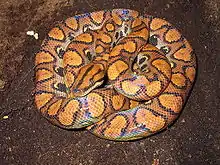
The rainbow boa (Epicrates cenchria) is a boa species endemic to Central and South America. A semi-arboreal species (not only do they climb in the wild but also proven in captivity), it is known for its attractive iridescent/holographic sheen caused by structural coloration. Five subspecies are currently recognized, including the nominate subspecies described here. (Full article...) Image 7
Image 7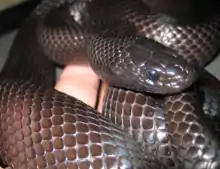
The Mexican black kingsnake (Lampropeltis getula nigrita) is part of the larger colubrid family of snakes, and a subspecies of the common kingsnake, which is debated by herpetologists to contain as many as 10 unique varieties. This species occupy rocky areas and places lush with vegetation in various regions of the Sonoran Desert, Northwestern Sinaloa, Mexico, and small parts of Arizona. (Full article...) Image 8
Image 8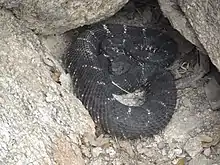
Crotalus cerberus is a venomous pit viper species found in the southwestern United States. It is known as the Arizona black rattlesnake, black rattlesnake, and several other common names. (Full article...) Image 9Atropoides picadoi, also known as Picado's jumping pitviper, is a species of venomous snake, a pitviper in the subfamily Crotalinae of the family Viperidae. The species is endemic to Costa Rica. There are no subspecies that are recognised as being valid. It is monotypic in the genus Atropoides. (Full article...)
Image 9Atropoides picadoi, also known as Picado's jumping pitviper, is a species of venomous snake, a pitviper in the subfamily Crotalinae of the family Viperidae. The species is endemic to Costa Rica. There are no subspecies that are recognised as being valid. It is monotypic in the genus Atropoides. (Full article...) Image 10
Image 10.jpg.webp) A red-bellied black snake in Lamington National Park, Queensland
A red-bellied black snake in Lamington National Park, Queensland
The red-bellied black snake (Pseudechis porphyriacus) is a species of venomous snake in the family Elapidae, indigenous to Australia. Originally described by George Shaw in 1794 as a species new to science, it is one of eastern Australia's most commonly encountered snakes. Averaging around 1.25 m (4 ft 1 in) in length, it has glossy black upperparts, bright red or orange flanks, and a pink or dull red belly. It is not aggressive and generally retreats from human encounters, but can attack if provoked. Although its venom can cause significant illness, no deaths have been recorded from its bite, which is less venomous than other Australian elapid snakes. The venom contains neurotoxins, myotoxins, and coagulants and has haemolytic properties. Victims can also lose their sense of smell. (Full article...) Image 11
Image 11
The Andaman cobra or Andaman spitting cobra (Naja sagittifera) is a species of cobra endemic to the Andaman Islands of India. The name of this cobra comes from the Islands itself. The species has a very potent venom, and is capable of “spitting”, although this defensive behavior is very rare and the aim is poor and not as efficient as “true spitting cobras”. (Full article...) Image 12
Image 12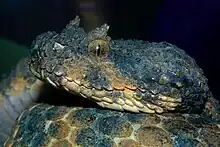 Persian horned viper (Pseudocerastes persicus)
Persian horned viper (Pseudocerastes persicus)
Pseudocerastes is a genus of vipers endemic to the Middle East and Asia. It was originally created as a monotypic genus in 1896 by Boulenger for the species Pseudocerastes persicus, but three species are now recognised: the spider-tailed horned viper (P. urarachnoides); Persian horned viper (P. persicus) and Field's horned viper (P. fieldi). Like all other vipers, the members of this genus are venomous. (Full article...) Image 13
Image 13
Snakes are elongated, limbless, carnivorous reptiles of the suborder Serpentes (/sɜːrˈpɛntiːz/). Like all other squamates, snakes are ectothermic, amniote vertebrates covered in overlapping scales. Many species of snakes have skulls with several more joints than their lizard ancestors, enabling them to swallow prey much larger than their heads (cranial kinesis). To accommodate their narrow bodies, snakes' paired organs (such as kidneys) appear one in front of the other instead of side by side, and most have only one functional lung. Some species retain a pelvic girdle with a pair of vestigial claws on either side of the cloaca. Lizards have independently evolved elongate bodies without limbs or with greatly reduced limbs at least twenty-five times via convergent evolution, leading to many lineages of legless lizards. These resemble snakes, but several common groups of legless lizards have eyelids and external ears, which snakes lack, although this rule is not universal (see Amphisbaenia, Dibamidae, and Pygopodidae). (Full article...) Image 14
Image 14
Crotalus unicolor, or the Aruba Island Rattlesnake, is a venomous pit viper species endemic to the Caribbean island of Aruba, off the coast of Venezuela. It is sometimes still classified as a subspecies of Crotalus durissus. (Full article...) Image 15
Image 15
Craspedocephalus brongersmai, also known commonly as Brongersma's pit viper, is a species of venomous snake in the subfamily Crotalinae of the family Viperidae. The species is native to islands off the west coast of Sumatra, Indonesia. No subspecies are currently recognized. (Full article...) Image 16
Image 16
Tantilla hobartsmithi, commonly known as the southwestern blackhead snake, is a species of small colubrid snake native to the southwestern United States and northern Mexico. (Full article...) Image 17
Image 17 Trimeresurus macrops - Khao Yai National Park, Thailand
Trimeresurus macrops - Khao Yai National Park, Thailand
Trimeresurus macrops is a venomous pit viper species endemic to Southeast Asia. No subspecies are currently recognized. Common names include large-eyed pitviper and green pit viper. (Full article...) Image 18
Image 18
The green tree python (Morelia viridis), also known as the emerald green python, is a species of snake in the family Pythonidae. The species is native to New Guinea, some islands in Indonesia, and the Cape York Peninsula in Australia. First described by Hermann Schlegel in 1872, it was known for many years as Chondropython viridis. As its common name suggests, it is a bright green snake that can reach a total length (including tail) of 2 m (6.6 ft) and a weight of 1.6 kg (3.5 lb), with females slightly larger and heavier than males. Living generally in trees, the green tree python mainly hunts and eats small reptiles and mammals. It is a popular pet, and numbers in the wild have suffered with large-scale smuggling of wild-caught green tree pythons in Indonesia. Despite this, the green tree python is rated as least concern on the IUCN Red List of endangered species. (Full article...) Image 19
Image 19
The Cape gopher snake or Baja gopher snake (Pituophis vertebralis) is a species of nonvenomous colubrid snake endemic to extreme southern Baja California Sur, Mexico. They have become increasingly popular companions for people interested in the exotic pet trade, due to their extreme color variations and relatively docile behavior. It was previously considered to be a subspecies of Pituophis catenifer.
There has been controversy whether the Baja Gopher Snake is a lower classification of the Cape Gopher Snake. Some say the Baja Gopher Snake should be in a separate sub-species of Pituophis Vertebralis Bimaris, while Cape Gopher Snakes should remain Pituophis Vertebralis Vertebralis.
Many people mistake the two as the same sub species and have cased some cross-breeding between the two.
In captivity the bloodlines are nearly all related and breeding has become especially difficult in terms of keeping the bloodlines alive. (Full article...) Image 20
Image 20
Austrelaps is a genus of venomous elapid snakes native to the relatively fertile, temperate, southern and eastern part of the Australian continent. Three species are currently recognized, with no subspecies. They are commonly called copperheads or Australian copperheads. They are not closely related to the American copperhead, Agkistrodon contortrix. (Full article...) Image 21
Image 21 Twin-spotted ratsnake
Twin-spotted ratsnake
Elaphe bimaculata, the twin-spotted ratsnake or Chinese leopard snake, is a small ratsnake (60–80 cm) found in China. It occurs as both blotched and striped phase, with the blotched type being the more common or "typical" phase. Some specimens even exhibit a pattern of half blotched, half striped where the anterior half is usually blotched and the posterior half striped. They are found in many habitats ranging from the edge of forest to cultivated areas and seem to like cooler temperatures and higher humidity. This secretive snake prefers smaller food items such as young to half grown mice. E. bimaculata has been known to breed at different times of the year, usually with 3-10 eggs being laid in late spring; eggs require 35–48 days of incubation. A period of 2–3 months hibernation is typical. Females are known to grow larger and heavier than males. (Full article...) Image 22
Image 22
Elaphe carinata, the king ratsnake (also known as Taiwan stink snake or Stinking Goddess), is a species of Colubrid snake found in Southeast and East Asia. (Full article...) Image 23
Image 23 Notechis scutatus
Notechis scutatus
The tiger snake (Notechis scutatus) is a large and highly venomous snake of southern Australia, including its coastal islands and Tasmania. These snakes are often observed and locally well known by their banding, black and yellow like a tiger, although the species can be highly variable in coloration and patterning. All populations are classified within the genus Notechis (Elapidae). Their diverse characteristics have been classified either as distinct species or by subspecies and regional variation. (Full article...) Image 24
Image 24 Notechis scutatus
Notechis scutatus
The tiger snake (Notechis scutatus) is a large and highly venomous snake of southern Australia, including its coastal islands and Tasmania. These snakes are often observed and locally well known by their banding, black and yellow like a tiger, although the species can be highly variable in coloration and patterning. All populations are classified within the genus Notechis (Elapidae). Their diverse characteristics have been classified either as distinct species or by subspecies and regional variation. (Full article...) Image 25
Image 25
Agkistrodon piscivorus is a species of venomous snake, a pit viper in the subfamily Crotalinae of the family Viperidae. It is one of the world's few semiaquatic vipers (along with the Florida cottonmouth), and is native to the Southeastern United States. As an adult, it is large and capable of delivering a painful and potentially fatal bite. When threatened, it may respond by coiling its body and displaying its fangs. Individuals may bite when feeling threatened or being handled in any way. It tends to be found in or near water, particularly in slow-moving and shallow lakes, streams, and marshes. It is a capable swimmer, and like several species of snakes, is known to occasionally enter bays and estuaries and swim between barrier islands and the mainland. (Full article...)
Selected lizard articles
 Image 1
Image 1
The leopard gecko or common leopard gecko (Eublepharis macularius) is a ground-dwelling lizard native to the rocky dry grassland and desert regions of Afghanistan, Iran, Pakistan, India, and Nepal. The leopard gecko has become a popular pet, and due to extensive captive breeding it is sometimes referred to as the first domesticated species of lizard. (Full article...) Image 2
Image 2_Singapore.jpg.webp) Singapore
Singapore
The clouded monitor (Varanus nebulosus) is a species of monitor lizard, native to Burma, Thailand and Indochina to West Malaysia, Singapore, Java, and Sumatra. They are excellent tree climbers. It belongs to the subgenus Empagusia along with the Bengal monitor, the Dumeril's monitor and other monitor lizards. It had previously been listed as a subspecies of Varanus bengalensis by some herpetologists. It is a diurnal monitor. (Full article...) Image 3
Image 3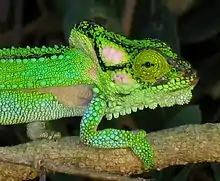
The Knysna dwarf chameleon (Bradypodion damaranum) is a species of dwarf chameleon in the Bradypodion ("slow footed") genus that is endemic to South Africa. It is a forest dweller, found only in a limited range in the afromontane forests near Knysna, South Africa, and in certain surrounding areas. (Full article...) Image 4
Image 4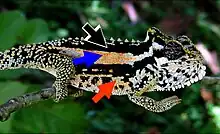
The Transvaal dwarf chameleon (Bradypodion transvaalense) is a chameleon native to South Africa, where it is found in forested areas of Mpumalanga and Limpopo provinces. It is also known as the Wolkberg dwarf chameleon, after the Wolkberg range. (Full article...) Image 5
Image 5_from_Barangay_Dibuluan%252C_San_Mariano_-_ZooKeys-266-001-g069.jpg.webp)
The Northern Sierra Madre forest monitor (Varanus bitatawa), also known by the local names bitatawa, baritatawa, and butikaw, is a large, arboreal, frugivorous lizard of the genus Varanus. The lizard is a distinctive food of the Aeta and Ilongot indigenous people of the Philippines. (Full article...) Image 6
Image 6 Preserved museum specimen
Preserved museum specimen
Draco mindanensis, commonly known as the Mindanao flying dragon or Mindanao flying lizard, is a lizard species endemic to the Philippines. Characterized by a dull grayish brown body color and a vivid tangerine orange dewlap, this species is one of the largest of the genus Draco. It is diurnal, arboreal, and capable of gliding. (Full article...) Image 7
Image 7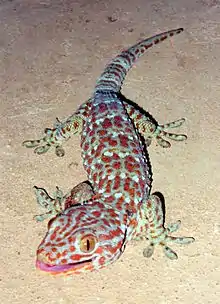
The tokay gecko (Gekko gecko) is a nocturnal arboreal gecko in the genus Gekko, the true geckos. It is native to Asia and some Pacific Islands. (Full article...) Image 8
Image 8 Female, Cologne Zoological Garden
Female, Cologne Zoological Garden
Brachylophus bulabula, commonly known as the Central Fijian Banded Iguana is a species of iguanid lizard endemic to some of the larger central and northwestern islands of Fiji (Ovalau, Kadavu and Viti Levu), where it occurs in Fijian wet forest. It was described by a team led by a scientist from the Australian National University in 2008. It is one of the few species of iguana found outside of the New World and one of the most geographically isolated members of the family Iguanidae. Initially also reported from Gau Island, in 2017 this population was described as a separate species, B. gau. They can grow up to 2 feet long and have an average lifespan of 10-15 years. However, there have been some captive Fiji banded iguanas that have lived as long as 25 years. Fijian banded iguana typically are found in tropical wet islands that are typically 650-1700 feet above sea level. They also like to bask in temperatures ranging from 75–95 °F (24–35 °C). The areas that are most suitable for Fiji banded iguanas are Viti Levu, Vanua Levu, Ovalau, Viwa, and Kadavu. Males are typically are green with blue stripes and the females are green with white stripes. (Full article...) Image 9
Image 9_from_Barangay_Dibuluan_-_ZooKeys-266-001-g046.jpg.webp)
Gehyra mutilata, also known commonly as the common four-clawed gecko, Pacific gecko, stump-toed gecko, sugar gecko in Indonesia, tender-skinned house gecko, and butiki in Filipino, is a species of lizard in the family Gekkonidae. The species is native to Southeast Asia. It has made its way to several areas of the world including Sri Lanka, Indochina, and many of the Pacific Islands. Compared to the common house gecko (Hemidactylus frenatus), the appearance of G. mutilata is somewhat plump, with delicate skin. The skin is usually colored a soft purplish/pinkish gray, with golden spots on younger specimens; these spots eventually fade with age. (Full article...) Image 10
Image 10 A Lesser Antillean iguana in Coulibistrie, Dominica
A Lesser Antillean iguana in Coulibistrie, Dominica
The Lesser Antillean iguana (Iguana delicatissima) is a large arboreal lizard endemic to the Lesser Antilles. It is one of three species of lizard of the genus Iguana and is in severe decline due to habitat destruction, introduced feral predators, hunting, and hybridization with its introduced sister species, the green iguana (Iguana iguana). Successful captive breeding of this species has been limited to only two instances, as most captive-laid eggs tend to be infertile. (Full article...) Image 11
Image 11
The ornate monitor (Varanus ornatus) is a monitor lizard that is native to West and Middle Africa. Comprehensive molecular analyses of the group have demonstrated that animals previously assigned to "Varanus ornatus" do not constitute a valid taxon and are actually polymorphisms of two different species; Varanus stellatus (west African Nile monitor) and Varanus niloticus (Nile monitor). Consequently, Varanus ornatus is considered a synonym of Varanus niloticus and "ornate monitor" is an informal term for forest forms of either species (V. niloticus or V. stellatus).
Until 1997, the ornate monitor was considered a subspecies of the Nile monitor. It was subsequently described as a separate species on the basis of reduced number of ocelli rows on the body, a light coloured tongue and a more massive build. More recent work based on a large sample size using mitochondrial and nuclear DNA sequences indicates that Varanus ornatus is not a valid species and that animals with the diagnostic appearance belong either of two sister species of Nile monitor. Animals described as ornate monitor lizards are native to closed canopy forests in West and Middle Africa. (Full article...) Image 12The short-limbed bend-toed gecko (Mediodactylus brachykolon) is a species of gecko. The gecko is distinguished from others due to its distinctly short limbs, stout body and large head. In appearance it is similar to Altiphylax stoliczkai and Altiphylax baturensis.
Image 12The short-limbed bend-toed gecko (Mediodactylus brachykolon) is a species of gecko. The gecko is distinguished from others due to its distinctly short limbs, stout body and large head. In appearance it is similar to Altiphylax stoliczkai and Altiphylax baturensis.
The name of the gecko comes from Greek brachys meaning short and kolon meaning limb. (Full article...) Image 13
Image 13_male_and_Borneo_Tree_Skink_(Dasia_vittata)_(15415237729).jpg.webp)
Draco cornutus is a species of "flying dragon", an agamid lizard. It is endemic to Borneo. It occurs at elevations up to 700 m (2,300 ft) above sea level, although its distribution is poorly known. (Full article...) Image 14
Image 14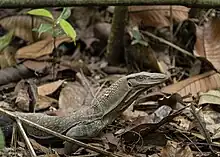
The black rough-necked monitor (Varanus rudicollis) is a species of monitor lizard found in Southeast Asian countries of Thailand, Burma, and Malaysia. It is also found in Indonesia on Sumatra and islands of the Riau Archipelago It is sometimes known simply as the roughneck monitor. In Thailand is called h̄èā cĥāng (Thai: เห่าช้าง; "elephant bark"). (Full article...) Image 15
Image 15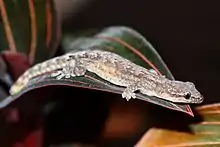
Lepidodactylus lugubris, known as the mourning gecko or common smooth-scaled gecko, is a species of lizard, a gecko of the family Gekkonidae. (Full article...) Image 16
Image 16 In the Melbourne Zoo
In the Melbourne Zoo
The Fiji crested iguana or Fijian crested iguana (Brachylophus vitiensis) is a critically endangered species of iguana native to some of the northwestern islands of the Fijiian archipelago, where it is found in dry forest on Yaduataba (west of Vanua Levu), Yadua, Macuata, Yaquaga, Devuilau (Goat island), Malolo, Monu and Monuriki. (Full article...) Image 17
Image 17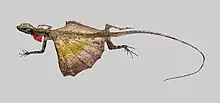
Draco volans, also commonly known as the common flying dragon, is a species of lizard in the family Agamidae. The species is endemic to Southeast Asia. Like other members of genus Draco, this species has the ability to glide using winglike lateral extensions of skin called patagia. (Full article...) Image 18
Image 18.jpg.webp)
The smooth helmeted iguana (Corytophanes cristatus), also known as the helmeted iguana, the helmeted basilisk, the elegant helmeted lizard, and several other common names, is a species of Basilisk and a New World lizard in the family Corytophanidae. The species is native to southern Mexico, Central America, and northwestern South America. (Full article...) Image 19
Image 19 Hybrid iguana near the boat landing on South Plaza Island
Hybrid iguana near the boat landing on South Plaza Island
The hybrid iguana is a first-generation hybrid, the result of intergeneric breeding between a male marine iguana (Amblyrhynchus cristatus) and a female Galapagos land iguana (Conolophus subcristatus) on South Plaza Island in the Galápagos Islands, where the territories of the two species overlap. (Full article...) Image 20
Image 20.jpg.webp) Draco maculatus in Thailand
Draco maculatus in Thailand
Draco maculatus, commonly known as the spotted flying dragon or spotted gliding lizard, is a species of agamid flying lizard endemic to Southeast Asia. It is capable of gliding from tree to tree. (Full article...) Image 21
Image 21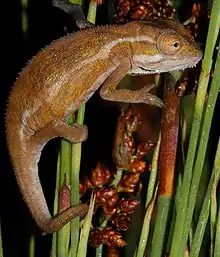
Smith's dwarf chameleon (Bradypodion taeniabronchum), also known as the Elandsberg dwarf chameleon, is a species of lizard in the family Chamaeleonidae endemic to Fynbos in South Africa's Eastern Cape. As in several species of chameleons in the genus Bradypodion, the Smith's dwarf chameleon can use its color-changing ability to actively camouflage itself depending on the vision of the specific predator species (for example, bird or snake) by which it is being threatened. (Full article...) Image 22
Image 22
Rhacodactylus is a genus of medium to large geckos of the family Diplodactylidae. All species in this genus are found on the islands that make up New Caledonia. (Full article...) Image 23
Image 23
The crested gecko or eyelash gecko (Correlophus ciliatus) is a species of gecko native to southern New Caledonia (France). In 1866, the crested gecko was described by French zoologist Alphonse Guichenot. This species was thought to be extinct until it was rediscovered in 1994 during an expedition led by Robert Seipp. Along with several other New Caledonian gecko species, it is being considered for protected status by the Convention on the International Trade in Endangered Species of Wild Flora and Fauna. (Full article...) Image 24
Image 24
Setaro's dwarf chameleon (Bradypodion setaroi) is a species of lizard in the family Chamaeleonidae. (Full article...) Image 25
Image 25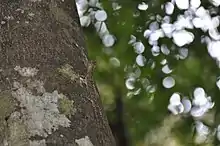 Draco indochinensis on a tree in Tân Phú district, Đồng Nai, Vietnam
Draco indochinensis on a tree in Tân Phú district, Đồng Nai, Vietnam
Draco indochinensis, also known as the Indochinese flying lizard or Indochinese gliding lizard, is a species of agamid lizard endemic to South-east Asia (Cambodia and southern Vietnam). (Full article...)
Categories
Selected turtle articles
 Image 1
Image 1 Balkan terrapin in captivity
Balkan terrapin in captivity
The Balkan terrapin or western Caspian terrapin (Mauremys rivulata) is a species of terrapin in the family Geoemydidae. It is found in the eastern Mediterranean region. While technically omnivorous, the terrapins are known to prefer meat. They can grow to 25 cm in carapace length, although hatchlings are usually only 3 to 4 cm in length. (Full article...) Image 2
Image 2 Northern Vietnamese box turtle
Northern Vietnamese box turtle
Cuora galbinifrons galbinifrons
The Indochinese box turtle, Vietnamese box turtle, or flowerback box turtle (Cuora galbinifrons) is a species of Asian box turtles from China (Hainan and Guangxi), northern and central Vietnam, Laos, and possibly northeastern Cambodia. It is found in high altitude woodland where it tends to hide in the undergrowth. There is considerable confusion as to the taxonomy of this species with several subspecies being recognised by some authorities. and not by others. The International Union for Conservation of Nature has rated its conservation status as "critically endangered". (Full article...) Image 3
Image 3_-_Filhote.jpg.webp) Young Podocnemis sextuberculata
Young Podocnemis sextuberculata
The six-tubercled Amazon River turtle or six-tubercled river turtle (Podocnemis sextuberculata) is a species of turtle in the family Podocnemididae. (Full article...) Image 4
Image 4
The black softshell turtle or Bostami turtle (Nilssonia nigricans), previously placed in genus Aspideretes, is a species of freshwater turtle found in India (Assam and Tripura) and Bangladesh (Chittagong and Sylhet). It was long believed to be inbred individuals of the Indian softshell turtle (A. gangeticus or N. gangeticus) or the Indian peacock softshell turtle (A. hurum or N. hurum), but while it is a close relative of the latter, it is a distinct species. In the 1800s it was believed these turtles were brought from Iran to Chittagong shrine pond by Hazrat Bayezid Bostami. His turtles he had brought to this pond were treated as sacred and respected by the public. Previously declared extinct by the International Union for Conservation of Nature in 2002, these turtles were found still to exist in a temple's pond called the Hayagriva Madhava Temple located in Assam, and in Kalyan Sagar lake in Tripura Sundari Temple in Udaipur, Tripura, India. Through conservation methods and protection of the species, some of these turtles can be found today throughout the wild, and scientists and environmental biologists are continuing to work hard to preserve this endangered species and their natural habitat. Their mitogenome represents relatedness to 19 other species of the Testudines. When looking at the phylogenetic tree, Nilssonia Nigricans are a species represented as sisters to Nilssonia formosa. (Full article...) Image 5
Image 5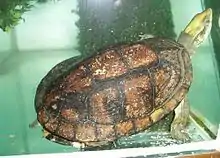 Pan's box turtle, Cuora pani pani
Pan's box turtle, Cuora pani pani
Pan's box turtle (Cuora pani) is a species of turtle in the family Geoemydidae (formerly Bataguridae). The yellow-headed box turtle is sometimes included herein as a subspecies (Cuora pani aurocapitata). (Full article...) Image 6
Image 6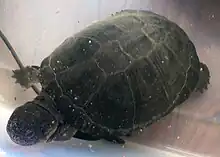
The West African mud turtle (Pelusios castaneus), also known as the West African side-necked turtle or swamp terrapin, is a species of turtle in the family Pelomedusidae.
Pelusios castaneus is a freshwater species and is endemic to West and Central Africa. (Full article...) Image 7
Image 7
The Fitzroy River turtle (Rheodytes leukops) is a species of freshwater turtle in the family Chelidae. It is the only surviving member of the genus Rheodytes, the other member being the extinct form Rheodytes devisi. The species is endemic to south eastern Queensland, Australia and only found in tributaries of the Fitzroy River. (Full article...) Image 8
Image 8
The Assam leaf turtle (Cyclemys gemeli) is a species of turtle in the family Geoemydidae. The species is native to India, Nepal, Bhutan, and Bangladesh. (Full article...) Image 9
Image 9
The black pond turtle (Geoclemys hamiltonii), also known commonly as the spotted pond turtle and the Indian spotted turtle, is a species of freshwater turtle in the family Geoemydidae. The species, which is endemic to South Asia, belongs to the monotypic genus Geoclemys. (Full article...) Image 10
Image 10
The eastern black-bridged leaf turtle (Cyclemys pulchristiata) is a species of Asian leaf turtles found in southern Indochina. (Full article...) Image 11
Image 11
The leatherback sea turtle (Dermochelys coriacea), sometimes called the lute turtle, leathery turtle or simply the luth, is the largest of all living turtles and the heaviest non-crocodilian reptile, reaching lengths of up to 1.8 metres (5 ft 11 in) and weights of 500 kilograms (1,100 lb). It is the only living species in the genus Dermochelys and family Dermochelyidae. It can easily be differentiated from other modern sea turtles by its lack of a bony shell; instead, its carapace is covered by oily flesh and flexible, leather-like skin, for which it is named. (Full article...) Image 12
Image 12 Graptemys ernsti
Graptemys ernsti
The Escambia map turtle (Graptemys ernsti), also known commonly as Ernst's map turtle, is a species of turtle in the family Emydidae. The species is endemic to the United States. (Full article...) Image 13
Image 13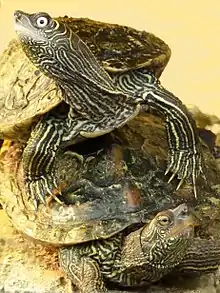 Top: Mississippi Map Turtle; Bottom: False Map Turtle
Top: Mississippi Map Turtle; Bottom: False Map Turtle
The Mississippi map turtle (Graptemys pseudogeographica kohni) is a subspecies of land and water turtle belonging to the family Emydidae. G. p. kohni is endemic to the central United States. (Full article...) Image 14The Central African mud turtle (Pelusios chapini) is a species of turtle in the family Pelomedusidae. The species is endemic to Central Africa. (Full article...)
Image 14The Central African mud turtle (Pelusios chapini) is a species of turtle in the family Pelomedusidae. The species is endemic to Central Africa. (Full article...) Image 15
Image 15
Adanson's mud turtle (Pelusios adansonii) is a species of turtle in the family Pelomedusidae. The species is endemic to north-central Africa. (Full article...) Image 16The Suwannee snapping turtle (Macrochelys suwanniensis) is a species of very large freshwater turtle in the family Chelydridae. This species is endemic to the southeastern United States, where it only inhabits the Suwannee River basin. (Full article...)
Image 16The Suwannee snapping turtle (Macrochelys suwanniensis) is a species of very large freshwater turtle in the family Chelydridae. This species is endemic to the southeastern United States, where it only inhabits the Suwannee River basin. (Full article...) Image 17The Fujian pond turtle ("Mauremys" × iversoni) is a possibly also naturally occurring intergeneric hybrid turtle in the family Geoemydidae (formerly Bataguridae) produced in larger numbers by Chinese turtle farms as a "copy" of the golden coin turtle Cuora trifasciata. It appears to occur in China and Vietnam. Before its actual origin became known, it was listed as data deficient in the IUCN Red List. (Full article...)
Image 17The Fujian pond turtle ("Mauremys" × iversoni) is a possibly also naturally occurring intergeneric hybrid turtle in the family Geoemydidae (formerly Bataguridae) produced in larger numbers by Chinese turtle farms as a "copy" of the golden coin turtle Cuora trifasciata. It appears to occur in China and Vietnam. Before its actual origin became known, it was listed as data deficient in the IUCN Red List. (Full article...) Image 18
Image 18
The spotted box turtle (Terrapene nelsoni) is a species of turtle in the family Emydidae. The species is endemic to the Sierra Madre Occidental in Mexico. (Full article...) Image 19
Image 19 Illustration of Morenia petersi
Illustration of Morenia petersi
The Indian eyed turtle (Morenia petersi) is a species of turtle in the family Geoemydidae. The species is endemic to South Asia. (Full article...) Image 20
Image 20_(17974863358).jpg.webp) Photographed in Uganda
Photographed in Uganda
The African helmeted turtle (Pelomedusa subrufa), also known commonly as the marsh terrapin, the crocodile turtle, or in the pet trade as the African side-necked turtle, is a species of omnivorous side-necked terrapin in the family Pelomedusidae. The species naturally occurs in fresh and stagnant water bodies throughout much of Sub-Saharan Africa, and in southern Yemen. (Full article...) Image 21
Image 21
The Asian leaf turtle (Cyclemys dentata) is a species of turtle found in Southeast Asia. They are quite common in the pet trade; their carapaces resemble that of a Cuora amboinensis hybrid. (Full article...) Image 22
Image 22
The northern map turtle (Graptemys geographica), also known as the common map turtle, is an aquatic turtle in the family Emydidae. It is endemic to North America. (Full article...) Image 23
Image 23
The bog turtle (Glyptemys muhlenbergii) is a critically endangered species of semiaquatic turtle in the family Emydidae. The species is endemic to the eastern United States. It was first scientifically described in 1801 after an 18th-century survey of Pennsylvania. The smallest North American turtle, its carapace measures about 10 centimeters (4 in) long when fully grown. Although the bog turtle is similar in appearance to the painted or spotted turtles, its closest relative is actually the somewhat larger wood turtle. The bog turtle can be found from Vermont in the north, south to Georgia, and west to Ohio. Diurnal and secretive, it spends most of its time buried in mud and – during the winter months – in hibernation. The bog turtle is omnivorous, feeding mainly on small invertebrates. The bog turtle is the state reptile of New Jersey. (Full article...) Image 24Galápagos turtle may refer to: (Full article...)
Image 24Galápagos turtle may refer to: (Full article...) Image 25
Image 25.JPG.webp) Female M. nigricans
Female M. nigricans
The red-necked pond turtle (Mauremys nigricans) is a species of turtles in the family Geoemydidae endemic to China. It is most likely restricted to Guangxi and Guangdong provinces, although pre-historic skull remains have been found in northern Vietnam and Hainan. Other common names include Kwangtung river turtle and black-necked pond turtle. (Full article...)
Need help?
Do you have a question about Reptiles that you can't find the answer to?
Consider asking it at the Wikipedia reference desk.
Topics
Major extant reptile clades | |||||
|---|---|---|---|---|---|
| Lepidosauria | |||||
| Archelosauria |
| ||||
Related portals
Associated Wikimedia
The following Wikimedia Foundation sister projects provide more on this subject:
-
 Commons
Commons
Free media repository -
 Wikibooks
Wikibooks
Free textbooks and manuals -
 Wikidata
Wikidata
Free knowledge base -
 Wikinews
Wikinews
Free-content news -
 Wikiquote
Wikiquote
Collection of quotations -
 Wikisource
Wikisource
Free-content library -
 Wikiversity
Wikiversity
Free learning tools -
 Wiktionary
Wiktionary
Dictionary and thesaurus
-
 List of all portals
List of all portals -

-

-

-

-

-

-

-

-

-
 Random portal
Random portal -
 WikiProject Portals
WikiProject Portals


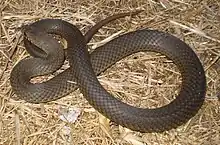

.jpg.webp)
